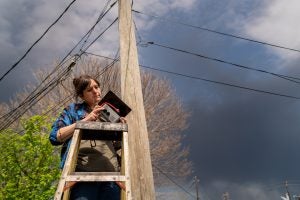With the Build Back Better Act, Congress has the opportunity to make an unprecedented investment in public health and the climate, particularly in the reduction of harmful air pollution, which disproportionately harms low-income residents and communities of color.
While many cities across the country have experienced an overall improvement in air quality, residents in neighborhoods from West Oakland, California to the 5th Ward in Houston must still fight for cleaner air, as heavy truck traffic and industrial pollution continue to seriously impact their health.

Air pollution is not evenly distributed across the places that people live, work, play and worship. A critical step in better understanding and taking action to reduce these inequities in air pollution impacts is to fill in the many gaps in our national air quality monitoring network.
Historic investments in air quality monitoring
This bill would help eliminate air pollution blindspots by providing at least $170 million for direct air quality monitoring, a near doubling of federal investment in such monitoring, which has dropped by 20% in real terms over the past 16 years.
It also allocates $50 million to monitor and reduce air pollution in schools that serve students from low-income communities.
This funding has the opportunity to make a tremendous impact on the health and wellbeing of children, as 1 in 5 of all new childhood asthma cases in the United States are attributable to traffic related air pollution. Asthma is a leading cause of school absenteeism, accounting for about 14 million absences each school year, or one-third of all school days missed.
Data-focused investing
The Build Back Better Act also recognizes that historically we have been investing in activities that cause or mitigate pollution with our eyes closed. The bill invites, and in some cases requires, insights about local pollution in order to apply for billions in grant funding available to mitigate pollution.
Specifically, the bill provides $5 Billion in planning and implementation for pollution reduction, and requires applications to include ‘‘(A) the degree to which greenhouse gas air pollution is projected to be reduced [in] low-income and disadvantaged communities.” Communities would be required to demonstrate how they will verify that pollution is decreasing after receiving the grants.
It also offers $4 Billion to mitigate or remediate the negative impacts of transportation, starting by monitoring or assessments of local and ambient air quality, transportation emissions, and hot spots of extreme heat or elevated air pollution.
These funds could be especially helpful in communities that bear the greatest cumulative burdens of pollution–those adjacent or downwind of major industries, plagued by heavy truck traffic and/or surrounded by highways–the consequence of systemic racism.
To address this, the bill includes $3 Billion in Environmental And Climate Justice Block Grants, which could include monitoring and mitigation of air pollution, and facilitate engagement of disadvantaged communities in state and federal public processes.
Opportunities to harness new technology
This bill comes at a time when technology and analytics like satellites and low-cost air pollution monitors are making it simpler to track pollution and its impacts. These insights will be critical to the accountability required by the grants and can help transform our understanding of where air pollution comes from, what it does to local health, and who is responsible.
With this historic funding, we can put the new, innovative methods to use at far greater scale, fueling a better understanding of how air pollution impacts health at the neighborhood level. With richer, more reliable data in hand, policymakers can focus mitigation efforts on areas with the highest burden and turn to solutions that have the potential for the greatest impact, especially for those who are most at risk.
